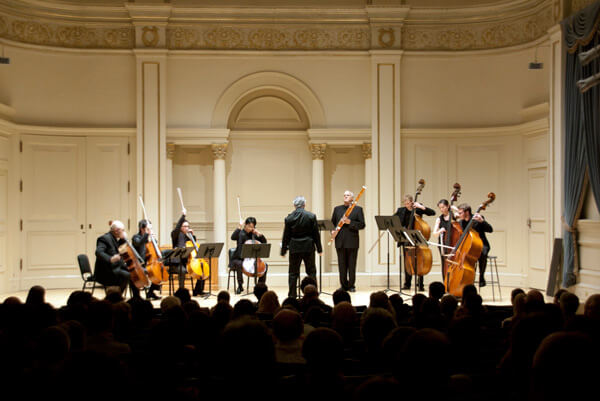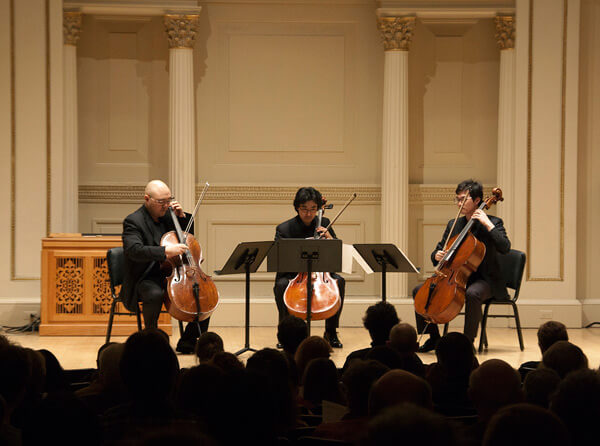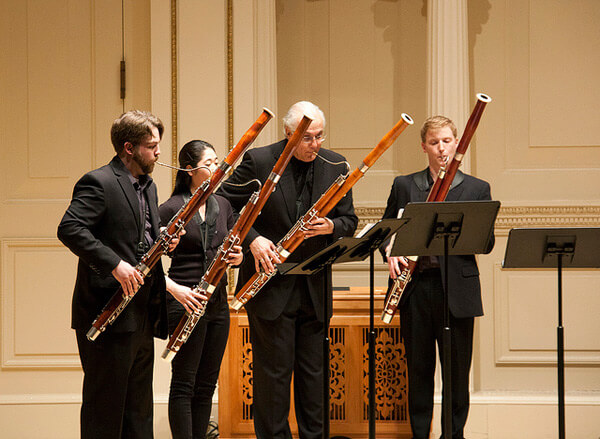 Bassoon, trombone, tuba, double bass, cello – in many musical textures, low voices are employed as a harmonic foundation, while a violin or soprano steals the spotlight and carries a melody. On April 1st at Carnegie’s Weill Recital Hall, Yale students, alumni and faculty demonstrated what instruments with low registers can do on their own. From the Baroque era to our own new century, composers have employed bass and tenor voices to create music ranging from jocose to somber, crafting melodies which test the limits of these instruments’ ranges, and even dispensing with melodies altogether in a profusion of experimental timbres. It must be a great privilege for students and recent alumni to perform with such accomplished faculty as bassoonist Frank Morelli, but also the ultimate incentive for musical discipline and maturity, which were on full display, though without detracting from the festive, sometimes tongue-in-cheek atmosphere of this exclusive club of musical characters.
Bassoon, trombone, tuba, double bass, cello – in many musical textures, low voices are employed as a harmonic foundation, while a violin or soprano steals the spotlight and carries a melody. On April 1st at Carnegie’s Weill Recital Hall, Yale students, alumni and faculty demonstrated what instruments with low registers can do on their own. From the Baroque era to our own new century, composers have employed bass and tenor voices to create music ranging from jocose to somber, crafting melodies which test the limits of these instruments’ ranges, and even dispensing with melodies altogether in a profusion of experimental timbres. It must be a great privilege for students and recent alumni to perform with such accomplished faculty as bassoonist Frank Morelli, but also the ultimate incentive for musical discipline and maturity, which were on full display, though without detracting from the festive, sometimes tongue-in-cheek atmosphere of this exclusive club of musical characters.

De Profundis: Gubaidulina’s Bassoon Concerto – Photo by Dana Astmann
Mozart’s Duo for bassoon and cello in B-flat major, K. 292 starts simply enough with the notes of the tonic triad, and as the instruments move either in parallel thirds or independently of one another, it is refreshing to hear the bassoon with the space to express itself removed from a thick orchestral texture where it often doubles another instrument. Morelli reached up into the high tenor range effortlessly and made good use of the hall, a great space for this throaty timbre. His vibrato was very smooth and natural. He and faculty cellist Ole Akahoshi proved this to be no mere novelty piece, but a full expression of Mozart’s expressive grace.
Penderecki’s Serenata for three cellos (2007) was composed for his wife’s birthday. Opening with hesitant pizzicato notes, the theme then emerges with the first five notes of a chromatic scale. A climax is reached with bowing so violent that it resonates more as slashing and grating than as tone. Akahoshi, alum Arnold Choi and student Sungchan David Chang ended the piece with an aggressive minor pizzicato chord. The composer’s Capriccio for solo tuba (1980) employs notes and scale fragments from widely different registers, which when juxtaposed give the effect of several voices interjecting upon one another. Alum Jerome Stover demonstrated an impressive array of timbres, from warm and smooth to rattling of bones. His controlled bursts of breathing almost become part of the musical line. The piece ends with a final flurry, a Gordian knot of indeterminate tone and flood of breath, before a final octave cadence.

De Profundis: Penderecki’s Serenata for three cellos – Photo by Dana Astmann
Jacob Druckman’s Valentine (1969) for solo double bass is a real showcase of a performer’s extended techniques and even comic delivery. Donald Palma (faculty) began playing the instrument with a timpani mallet, on the tailpiece, and eventually over every surface of the instrument. He whispered musical instructions (“performer switches from mallet to bow”) in a hurried frenzy, to the delight of the unsuspecting audience, then engaged in vocal percussion while bowing, essentially creating a duet with the voice – “Yow! Whoop?”, as though it were a Roy Lichtenstein pop art piece turned into performance art. Pizzicato tremolo was matched with “Manamanamana” – was he mocking his own instrument?! His teachers Copland and Persichetti no doubt, influenced Druckman in the dominance of these comic events and surprise rhythms, but passages of the piece almost resemble an ironic, self-deprecating kabuki-meets-Luciano Berio.
Prokofiev’s Humorous Scherzo for eight bassoons is the sound of a circus tent being struck, the instruments evoking many characters, from an elephant to a trapeze artist, but coming together in a rich harmony. The same instruments, plus contrabassoon, tackle a monumental transcription of Bach’s Toccata and Fugue in D minor. Although it started out sounding like a novelty arrangement, it becomes evident that the performers (Morelli and assorted students) were driven to prove their bassoons equal to the task of expressing the diverse styles contained in this piece. Imitative passages showed the subtle differences in tone between individual instruments.
Schütz’s Absalon, fili mi was the sole Baroque piece in the program, scored for four sackbuts, bass voice and continuo and based on a text from the second book of Samuel. The sackbut is progenitor to the trombone, with a smaller bell flare and tubing of varying length, and these instruments handle resolutions of dissonant suspensions and cadences in various keys – hallmarks of the Schütz style – with elegance. One wonders why such beautiful instruments ever went out of fashion, able to achieve the brightness of a trumpet without losing their essential richness and warmth. Bass-baritone Taylor Ward captured the dignified lament of the biblical tale of David losing his third son.

De Profundis – Schütz: Absalon, fili mi – Photo by Dana Astmann
Sofia Gubaidulina’s Concerto for bassoon and low strings (1975), conducted by Ranson Wilson (faculty), featured Morelli as soloist and an assortment of students and recent alums on four cellos and three double basses. It opens on a bassoon recitative in the extremely high register (a nod to Le Sacre du Printemps?). Strings echo short bassoon motifs, but these motifs then quickly decompose into tremolo glissandos. Tutti sections experiment with abrasive timbres and effects from all the instrumentalists. Harmonics in the strings provide a Ligeti-like atmospheric dread. The second movement features tone-clouds in the strings, dry, but moving in step, until they coalesce into a single tone, taken up by the bassoon, only to have the soloist break down into a multi-phonic growl. Nature sounds can be heard in the third movement, birdsong in the bassoon, buzzing of locusts created by cello harmonics, etc. There is a playful experimental quality in the bow-bouncing (spiccato), unpredictable dynamic and rhythmic surprises, the eight voices rarely producing the same sound but always clearly outlining a compositional plan. The fourth movement is an industrial frenzy, not so much composed as choreographed, the instruments striking poses, which seem like the antithesis of melody (laughing in the bassoon!). The last movement features aleatoric pizzicato (the conductor standing still and allowing freedom to the performers) and col legno battuto (hitting with the wood of the bow) while the bassoon spins out a jazzy swing line.
It is often suspected that unusual scoring is a contemporary composer’s attempt at a new marketing strategy, but that night’s inclusion of repertoire from diverse historical periods proved that the focus on low voices has long been fertile ground for creative experimentation. As listeners, we strive to develop our appreciation of musical idiosyncrasies as well as more standard fare, and Yale in New York’s engaging program, for which Artistic Director David Shifrin should be commended, successfully brought these low voices “out of the depths” and onto equal footing with their higher-register relatives.
—
Rob Wendt is a pianist / composer / music educator living in Astoria, NY. You can follow him on twitter: @RobWendt




















